 Joan Baldwin’s paintings reveal the secret lives of furniture and, in her most recent work, the subject is doll furniture. The tiny chairs and bathroom fixtures are at Cape Cod in the summertime, nestling in gorgeously painted foliage, sat upon by finches, eddying in a tiny tidepool in the company of small shells.
Joan Baldwin’s paintings reveal the secret lives of furniture and, in her most recent work, the subject is doll furniture. The tiny chairs and bathroom fixtures are at Cape Cod in the summertime, nestling in gorgeously painted foliage, sat upon by finches, eddying in a tiny tidepool in the company of small shells.
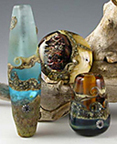 Betty Hanssen has been creating lampwork glass beads for a decade or more. Many of her beads portray miniature worlds, like these three sea beads. Each one is less than three inches tall and reproduces a slice of marine ecosystem, with sand, waves, and surprising sea creatures living in a kind of personal ocean.
Betty Hanssen has been creating lampwork glass beads for a decade or more. Many of her beads portray miniature worlds, like these three sea beads. Each one is less than three inches tall and reproduces a slice of marine ecosystem, with sand, waves, and surprising sea creatures living in a kind of personal ocean.
 Ilisha Helfman makes elaborate, die-cut folding environments, including functioning dollhouses made of paper complete with pop-up furniture and accessories. Her love of pattern, color, and intensely detailed miniature worlds grew from a girlhood devotion to making miniature lamps, rugs, and even miniature weaving and embroidery for a dollhouse. Helfman’s commercial design clients include television networks and art book publishers, and she is the author of books and articles on jazz knitting.
Ilisha Helfman makes elaborate, die-cut folding environments, including functioning dollhouses made of paper complete with pop-up furniture and accessories. Her love of pattern, color, and intensely detailed miniature worlds grew from a girlhood devotion to making miniature lamps, rugs, and even miniature weaving and embroidery for a dollhouse. Helfman’s commercial design clients include television networks and art book publishers, and she is the author of books and articles on jazz knitting.
Photographer Susan Huszar has recently begun building dollhouses and miniature environments in 1:12 scale. The show features “Listen to Your Heart”, a 12” high tent, containing a single ear, which reclines on a rhinestone studded chaise. Her miniature environments are both surreal and poignant, and often involve the viewer directly in activating the tiny sculptures.
 Napoleon Jones-Henderson has created a 6-foot-tall multimedia shrine “4 Little Girls 16th St Baptist Church.” The reference, of course, is to the 1963 arson of a Birmingham, Ala., church which helped galvanize the civil rights movement. A small wooden model with cutaway walls represents the church. It is photomontaged inside and out with images of hardship reaching back into the days of slavery. In one corner, each girl’s face is pasted onto an ancient Egyptian coffin. This structure sits atop a column draped in heavily patterned fabric scales and cowrie shells. This piece is both a memorial and a reminder that, ultimately, beauty can be used as a weapon against ugliness.
Napoleon Jones-Henderson has created a 6-foot-tall multimedia shrine “4 Little Girls 16th St Baptist Church.” The reference, of course, is to the 1963 arson of a Birmingham, Ala., church which helped galvanize the civil rights movement. A small wooden model with cutaway walls represents the church. It is photomontaged inside and out with images of hardship reaching back into the days of slavery. In one corner, each girl’s face is pasted onto an ancient Egyptian coffin. This structure sits atop a column draped in heavily patterned fabric scales and cowrie shells. This piece is both a memorial and a reminder that, ultimately, beauty can be used as a weapon against ugliness.
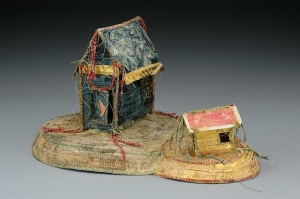 Donna Rhae Marder weaves tiny, complex architecture from materials like telephone wire, candy wrappers, and old phone books. Marder’s work is minutely detailed, using the repetitive processes of women’s home handicraft (quilting, folding, stitching, tying). “Rapunzel’s Tower” literally bristles with allusion, in a space where there is no distinction between physical and imaginary worlds. Marder’s houses are representative of people in many ways. The two small houses pictured here, each on its own island, conjure up a couple who live not quite together, yet not exactly in isolation.
Donna Rhae Marder weaves tiny, complex architecture from materials like telephone wire, candy wrappers, and old phone books. Marder’s work is minutely detailed, using the repetitive processes of women’s home handicraft (quilting, folding, stitching, tying). “Rapunzel’s Tower” literally bristles with allusion, in a space where there is no distinction between physical and imaginary worlds. Marder’s houses are representative of people in many ways. The two small houses pictured here, each on its own island, conjure up a couple who live not quite together, yet not exactly in isolation.
Boston sculptor Karen Meninno concocts tiny fimo “confections,” neither candy nor architecture, but a bit of both. Karen lays out a conglomeration of miniatures that form a small and intensely colorful landscape, even a tiny nation.
 Marielle Sinclair’s minute, highly detailed sculptures are abject, even nightmarish visions in cloth, wax and metal. Two-headed rabbits, sentient arachnids, and skeletal puppets, crafted in wire, beads, and fur, exude a dark, yet charming, inner life.
Marielle Sinclair’s minute, highly detailed sculptures are abject, even nightmarish visions in cloth, wax and metal. Two-headed rabbits, sentient arachnids, and skeletal puppets, crafted in wire, beads, and fur, exude a dark, yet charming, inner life.
Sharon Pierce’s peepshow boxes offer a disturbing glance into miniature interiors filled with ambiguity. Although not dollhouses in any traditional sense, her dollhouse-scale environments nonetheless mirror the voyeuristic experience of looking into a tiny, domestic world–but one fraught with anxiety, or even menace.
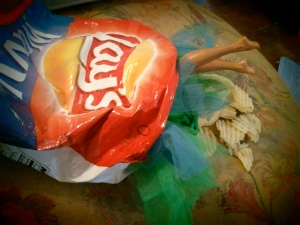 Photographer Alison Power has a wicked sense of humor, and in “My Barbie/My Self” she imagines what her old Barbie does when no one else is home. Smoking, drinking, gorging on potato chips…Barbie gives up fashion and goes over to the dark side.
Photographer Alison Power has a wicked sense of humor, and in “My Barbie/My Self” she imagines what her old Barbie does when no one else is home. Smoking, drinking, gorging on potato chips…Barbie gives up fashion and goes over to the dark side.
Built, wired and decorated by Salem artist Sharon Shea, “Salem Witch House” is both an affectionate tribute to the kitschy, witch-theme-park aspects of life in Salem, Massachusetts, and a true Halloween house, where unexpected things happen. Though at first glance it looks like an ordinary toy—and is the closest thing to a traditional dollhouse in the show—the artist has included details from her own life.
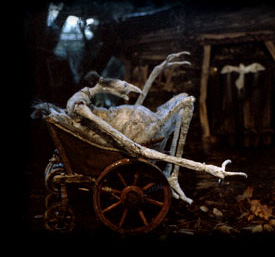 Filmmaker Jeff Sais and Bryan Papciak of the collective HandcrankedFilm in Waltham built a pie-shaped dollhouse set for their animation, “Monkey Train.” Sais has also built intricate environments for Sesame Street’s “Grandma Cookie Monster” and “Grandma Big Bird,” riotous apartments where everything is either egg-shaped, or lumpy and cookie-like. Shown is a witch puppet, star of Jeff’s student stop-motion film, “A Look Through the Keyhole.”
Filmmaker Jeff Sais and Bryan Papciak of the collective HandcrankedFilm in Waltham built a pie-shaped dollhouse set for their animation, “Monkey Train.” Sais has also built intricate environments for Sesame Street’s “Grandma Cookie Monster” and “Grandma Big Bird,” riotous apartments where everything is either egg-shaped, or lumpy and cookie-like. Shown is a witch puppet, star of Jeff’s student stop-motion film, “A Look Through the Keyhole.”
Maria Sanchez Kouassi’s doll-size women exist to serve, in an abjectly literal fashion. Their heads are hollowed out to form spoons or bowls, bodies serving as handles. Sanchez’s tiny women have subsumed themselves to their domestic function and become serving implements. However, Sanchez rescues them by glazing them with gorgeous surfaces: gold and silver, textures like granite or marble, which smolder like ancient stones.
Baltimore-area artist Lynn Thomas has created a miniature home of the imagination, in which Andre Breton and Mother Ann Lee write their spiritual treatises. Poised at writing tables, pencils in hand, the founders of Surrealism and the Shakers each pursue a world-changing vision.
Carolyn Wirth and documentary filmmaker Alice Apley collaborated on the video, “The Meditation Room,” an animation using dollhouse furniture. The protagonist of the film–a ticking clock–marks the passage of time as the tiny room is carefully arranged, and then dissolves.
http://www.youtube.com/watch?v=p2uIlH2z24U
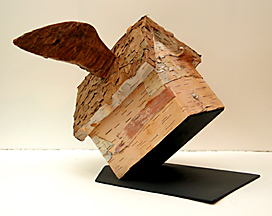 Sculptor Joyce Audy Zarins normally welds large-scale metal sculptures that relate to trees. This small house, made of bark and maple keys, is titled “Sustainability.” Joyce literally gives wings and a launchpad to her tiny cabin, a repository for her hopes for a better environmental future.
Sculptor Joyce Audy Zarins normally welds large-scale metal sculptures that relate to trees. This small house, made of bark and maple keys, is titled “Sustainability.” Joyce literally gives wings and a launchpad to her tiny cabin, a repository for her hopes for a better environmental future.
Painter Diana Zipeto has contributed a life-size portrait of “Ginny”, the 8-inch girl doll designed by Somerville native Virginia Graves, the inspiration for this show. This well-loved Ginny represents a doll dynasty that has touched 4 generations of the Zipeto family, all enthusiastic Ginny owners.
 This show was sponsored in part by the Somerville Arts Council, a local agency of the Massachusetts Cultural Council, www.massculturalcouncil.org.
This show was sponsored in part by the Somerville Arts Council, a local agency of the Massachusetts Cultural Council, www.massculturalcouncil.org.

To my friends participating in this show: I am so glad to see this! I look forward to visiting and checking it out.
This is going to be great! Can’t wait!